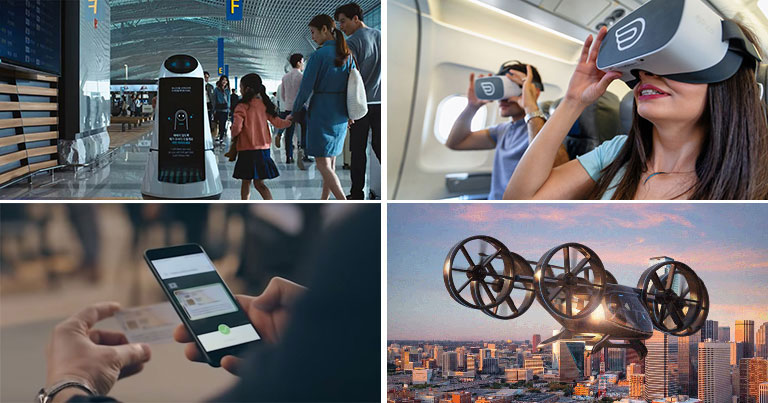Introduction
As airports continue to evolve in response to changing technology, passenger expectations, and global events, several key trends are shaping the future of air travel. From the integration of advanced technologies that enhance operational efficiency to a growing emphasis on sustainability and passenger comfort, modern airports are transforming into smart, eco-friendly hubs.

Airport trends
This article explores the latest developments in airport trends, highlighting innovations, changes in passenger services, security enhancements, and the impact of global events, ultimately painting a comprehensive picture of how the aviation landscape is adapting to the needs of tomorrow.
Overview of Current Airport Trends
Airports are becoming more than just points of entry to new destinations; rather, they are evolving into intricate ecosystems that adapt to the shifting preferences of passengers and operational demands. With a surge in air travel post-pandemic and an increasing focus on sustainability, the airport landscape is witnessing exciting transformations. In this whirlwind of change, technology and innovation are taking center stage, reshaping how we experience flying from check-in to boarding.
Market Analysis and Growth Projections
According to industry forecasts, global air travel is set to soar, with projections estimating over 8 billion passengers by 2037. Airport capacity and modernization investments are being driven by this rise. Major players in the industry are racing to enhance infrastructure and operations to accommodate this growth, ensuring that travelers are met with efficiency and comfort.
The market for airport technology alone is expected to reach billions in the coming years, making it a veritable goldmine for innovators and investors alike.
Key Drivers Influencing Change
Several factors are propelling these changes, including soaring passenger numbers, heightened security concerns, and an increased focus on environmental impact. The pandemic has also reshaped traveler behaviors, with people now demanding more health-focused measures.
Additionally, digital transformation is not just a trend but a necessity. Airports are adopting cutting-edge technologies to streamline processes and improve customer satisfaction, which all boils down to keeping passengers happy (and slightly less cranky during layovers).
Technological Innovations in Airport Operations
The airport industry is embracing technology like never before, moving away from traditional experiences and toward streamlined procedures that hardly require human intervention—imagine “Jetsons” and “The Terminal” mixed together.
Automation and Robotics in Baggage Handling
Imagine a world in which your suitcase is more than just a bag—it’s an expertly trained, self-sufficient companion who knows exactly where to go. To speed up processes and reduce errors, airports are increasingly using robotics and automation in baggage handling. This tech-savvy approach minimizes the chances of your luggage embarking on a solo adventure to a completely different destination.
Smart Airports: IoT and Data Analytics
IOT (Internet of Things) is the magic ingredient making airports smarter. From smart lighting systems that adapt based on foot traffic to real-time data analytics that predict passenger flow, technology is creating a seamless travel experience. Airports are utilizing sensors and analytics to optimize operations, reducing wait times and enhancing overall efficiency. It is similar to having a personal concierge who is also an algorithm.
Mobile Technology and Passenger Engagement
Gone are the days of fumbling with paper tickets and waiting in endless queues. Airports are ramping up mobile technology to enhance passenger engagement, providing apps that offer everything from flight updates to gate changes, and even food recommendations. With features like mobile check-ins and digital boarding passes, travelers are now just a tap away from a smoother airport experience—unless, of course, their phone battery dies.
Sustainability Initiatives in Airport trends Design
Airports are not just aiming for efficiency; they’re also striving to be environmentally friendly. After all, who wants to start a vacation with a guilty conscience?
Green Building Practices and Materials
Modern airport designs are increasingly incorporating sustainable building practices and materials. Airports are evolving into eco-friendly giants that prioritize eco-friendliness without sacrificing aesthetics, using everything from solar panels to rainwater harvesting systems. These initiatives not only minimize their carbon footprint but also create spaces that are pleasant for travelers and the environment alike.
Airport trends and Use of Renewable Energy Sources
In order to power their operations, many airports are turning to renewable energy sources. Whether it’s solar, wind, or geothermal energy, these initiatives are reducing reliance on fossil fuels and lowering emissions.
Some airports are even producing more energy than they use, establishing themselves as examples of sustainability in the aviation sector. If only they could figure out how to power boarding announcements with the energy of impatient travelers.
Waste Reduction and Recycling Programs
To combat the waste generated by millions of travelers, airports are implementing waste reduction and recycling programs. Airports are doing more to reduce their impact on the environment, starting with zero-waste initiatives and composting food scraps. These programs not only help the planet but can also educate travelers on sustainable practices, proving that we can enjoy our journeys without trashing the Earth.
Changes in Passenger Experience and Services
The flying experience has evolved from merely getting from point A to point B. Nowadays, it’s more about how to make that journey as pleasant and memorable as possible.
Personalization and Customization of Services

Travelers are increasingly getting services that are tailored to their specific preferences and requirements at airports. From selecting meal options in advance to customized lounge access based on travel history, passengers can enjoy a tailored experience that makes them feel valued. With none of the awkward small talk, it’s like having a personal assistant.
Post-Pandemic Health and Safety Measures
Post-pandemic, health and safety measures have taken center stage. Airports are implementing enhanced cleaning protocols, contactless technologies, and health screening procedures to ensure passengers feel safe. The days of dodging germs like a ninja in an airport are waning, as these measures provide peace of mind for travelers eager to spread their wings.
Enhancements in Airport Amenities and Retail
Airports are reinventing themselves by enhancing amenities and retail options to keep passengers entertained and comfortable during layovers. With everything from high-end shops to gourmet dining options, modern airports are becoming destinations in their own right.
Who knew you could do some luxury shopping while waiting for your flight? Just keep an eye on your watch, or else you could be the person who runs for the gate with a handbag that costs too much.
Security Enhancements and Protocol Updates
Advanced Screening Technologies
Airport trends are embracing cutting-edge technologies to make security checks faster and less stressful. Imagine walking through a scanner that not only detects weapons but can also assess your gummy bear stash without requiring you to unpack your bag.
Innovations like 3D imaging and AI-assisted systems are transforming security lanes into high-tech checkpoints, allowing travelers to glide through with more ease—and less time spent playing the “what’s in my bag?” game.
Collaboration with Government Agencies
Gone are the days when airports operated independently in the security arena. Nowadays, collaboration with government agencies is vital for keeping travelers safe while navigating the complex web of regulations.
Airports are joining forces with TSA, DHS, and even international entities to create protocols that can adapt to emerging threats and streamline the travel experience. It’s like the ultimate team-up—think Avengers, but with less spandex and more scanners.
Impact of Cybersecurity on Airport Operations
Airport trends are now confronted with the daunting challenge of cybersecurity, as if physical security wasn’t enough. A cyberattack could ground planes faster than a flock of geese because digital networks are used for everything from flight controls to ticketing systems.
To ensure that our travel plans are not destroyed by a rogue hacker with a penchant for chaos, airport trends are investing in robust cybersecurity measures, such as regular threat assessments, employee training, and cutting-edge anti-hacking technologies.
Impact of Global Events on Airport Trends

Effects of the COVID-19 Pandemic
The pandemic turned the aviation industry upside down, transforming airport trends into abandoned ghost towns overnight. As travelers cautiously returned to the skies, airports had to adapt rapidly, implementing health protocols like contactless check-in, mask mandates, and social distancing measures.
Who would have thought that hand sanitizer stations would become as widespread as baggage claim carousels? This health crisis reshaped everything, and airports are still navigating the long-term impacts on traveler behavior and safety expectations.
Geopolitical Factors and Travel Restrictions
Geopolitical drama shakes up air travel like nothing else. With fluctuating travel restrictions based on diplomatic relations, airports need to stay nimble. One day you might be booking a flight to a sunny destination, and the next, it’s a no-fly zone due to political tensions.
In response, airports are adapting their marketing strategies and working on partnerships to mitigate the impacts of these ever-changing circumstances, ensuring that their flight boards keep lighting up—hopefully not with “canceled” signs.
Economic Trends and Their Influence on Air Travel
Air travel is more than just wheels and wings; economic trends are deeply entwined with it. Due to fluctuatin and data intelligence, they are redefining what it means to travel seamlessly and safely. The integration of smart infrastructure, AI-driven insights, and eco-friendly initiatives signals a future where airports are not just transit points but dynamic, intelligent ecosystems that enhance both operational excellence and passenger well-being.
FAQs
Q1. What are the most significant airport trends shaping the future of air travel?
Digital transformation through AI and biometrics, sustainable airport trends design, advanced passenger flow management, contactless technologies, and data-driven operations are the most influential airport trends. Airports are also investing heavily in renewable energy and smart infrastructure to enhance efficiency and reduce carbon footprints.
Q2. How is technology transforming airport trends operations?
Technology plays a key role in optimizing every stage of the passenger journey — from AI-powered security screening and automated baggage handling to predictive maintenance and real-time analytics. Airport trends are increasingly integrating IoT systems and cloud platforms to streamline operations and improve decision-making.
Q3. What green initiatives are airports implementing?
Airport trends are adopting green building practices, using electric ground vehicles, investing in solar energy, and implementing carbon offset programs. Many major hubs are moving toward net-zero emission goals and utilizing sustainable aviation fuel (SAF) in collaboration with airlines.
Q4. How are airport trends enhancing the passenger experience?
Passenger experience is being elevated through digital wayfinding, personalized communication, smart retail, and seamless security checkpoints. Contactless boarding, biometric verification, and AI-driven service chatbots are becoming standard features that reduce wait times and stress.
Q5. What role does data analytics play in modern airports?
Data analytics supports real-time decision-making for crowd control, flight scheduling, and resource allocation. By analyzing passenger behavior patterns, airports can predict demand, manage congestion, and enhance operational efficiency.
Q6. How is the concept of “smart airports” evolving?
To create ecosystems that are fully integrated, smart airport trends combine automation, connectivity, and artificial intelligence. From digital twins for facility management to real-time monitoring through IoT sensors, the smart airport model enables proactive management of logistics, security, and energy systems.
Q7. How did the COVID-19 pandemic affect in airport trends?
The pandemic accelerated touch-free check-ins, contactless technologies, and automated health screenings. It also pushed airports to rethink terminal design, improve air filtration systems, and focus on passenger safety and digital engagement.
Q8. What are the future predictions for airport trends development?
Future airports will likely focus on autonomous systems, AI-driven forecasting, hybrid air mobility hubs (including drones and air taxis), and ultra-efficient passenger journeys. Airport development around the world will continue to be influenced by sustainability and digital innovation.
Conclusion
The global airport landscape is undergoing a transformative shift fueled by technological innovation, environmental responsibility, and evolving passenger expectations. As airport trends embrace automation, sustainability, and data intelligence, they are redefining what it means to travel seamlessly and safely.
The integration of smart infrastructure, AI-driven insights, and eco-friendly initiatives signals a future where airports are not just transit points but dynamic, intelligent ecosystems that enhance both operational excellence and passenger well-being.
